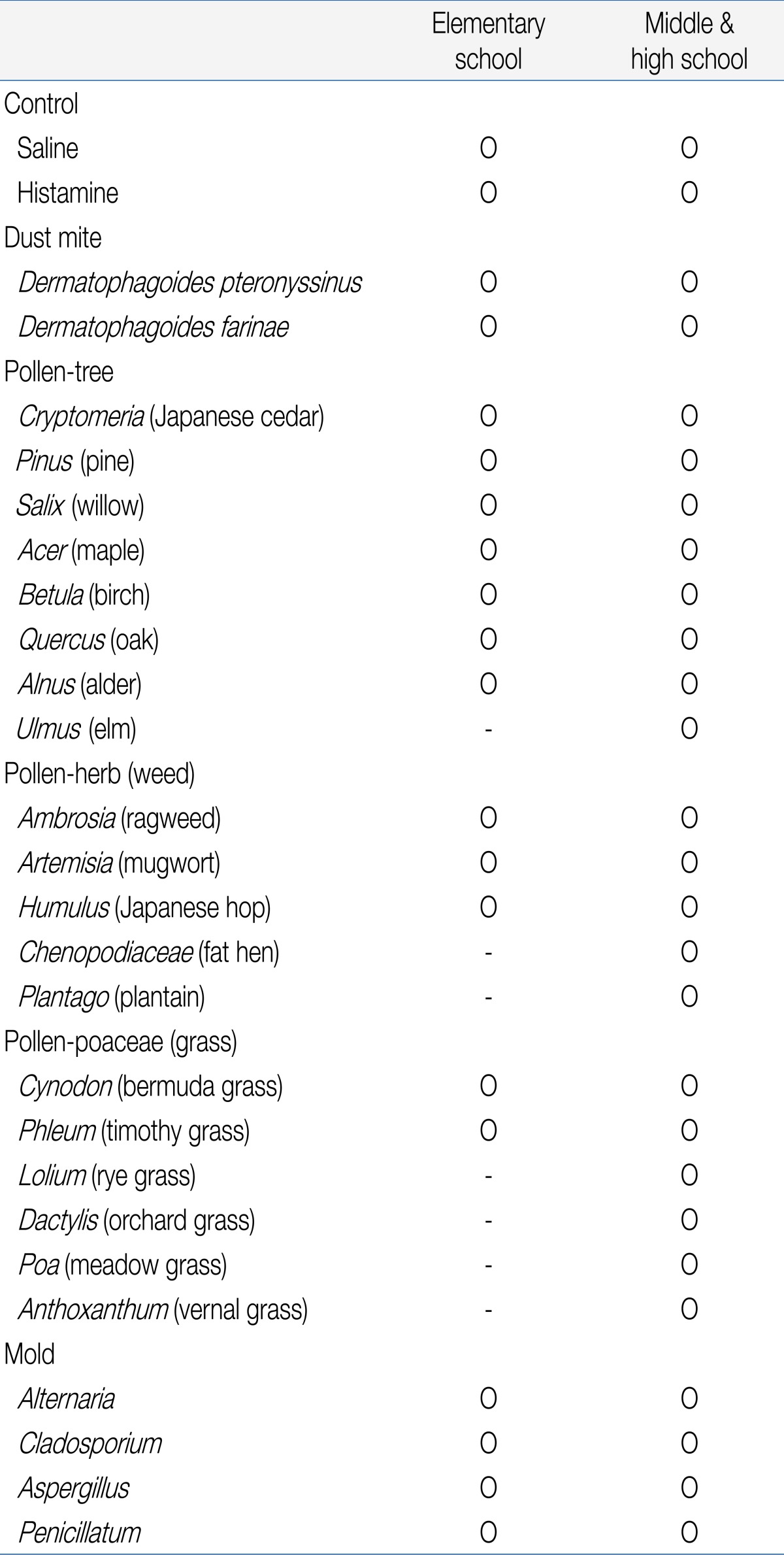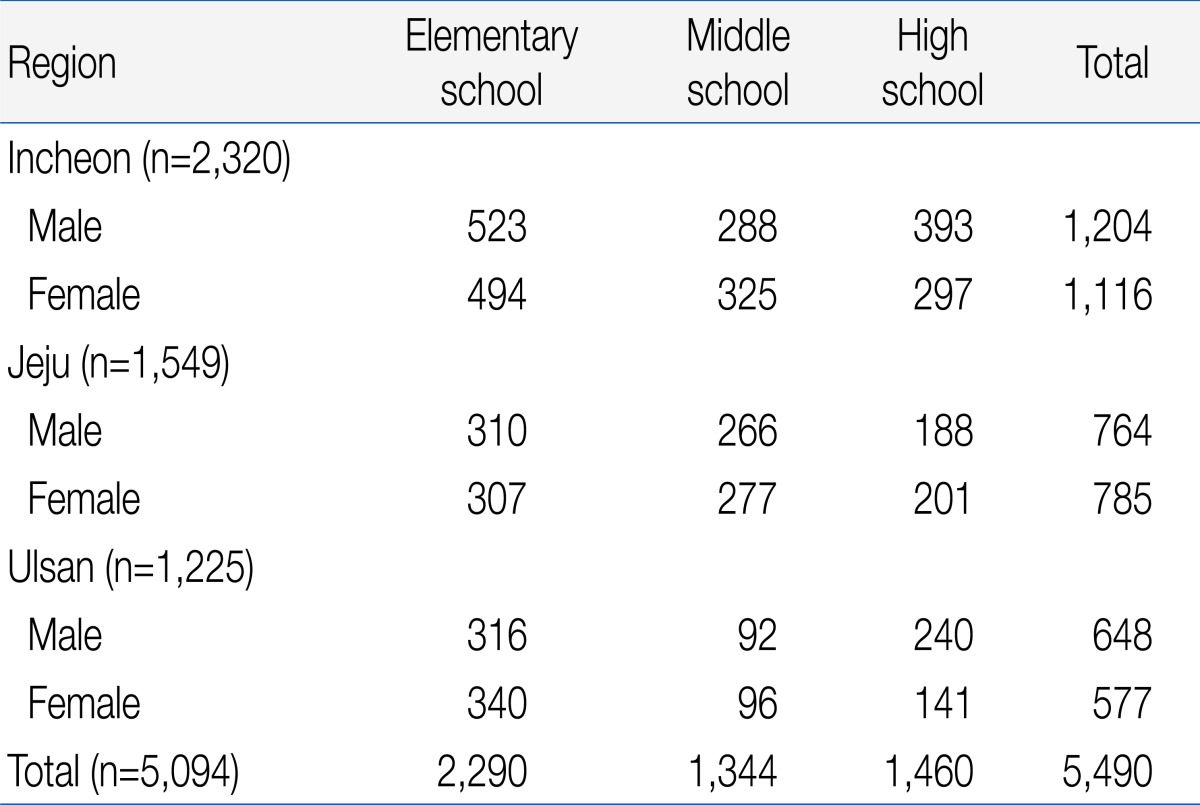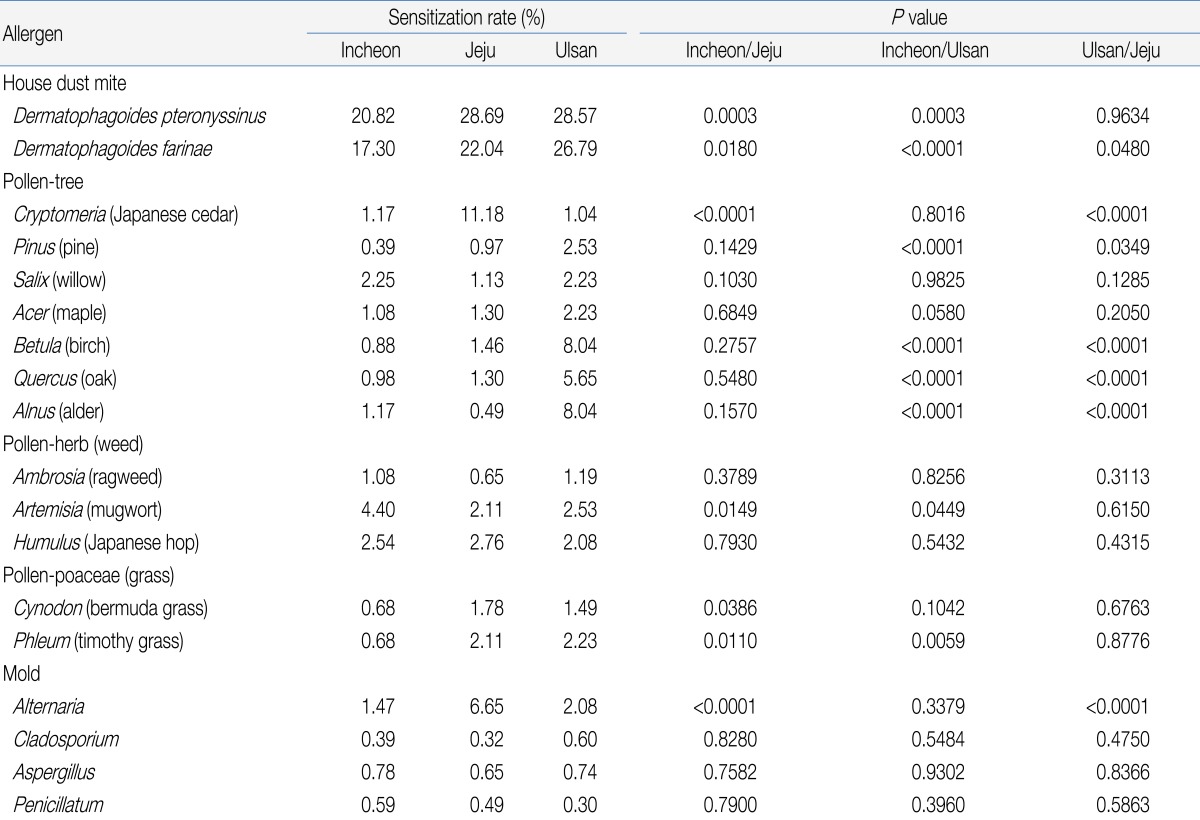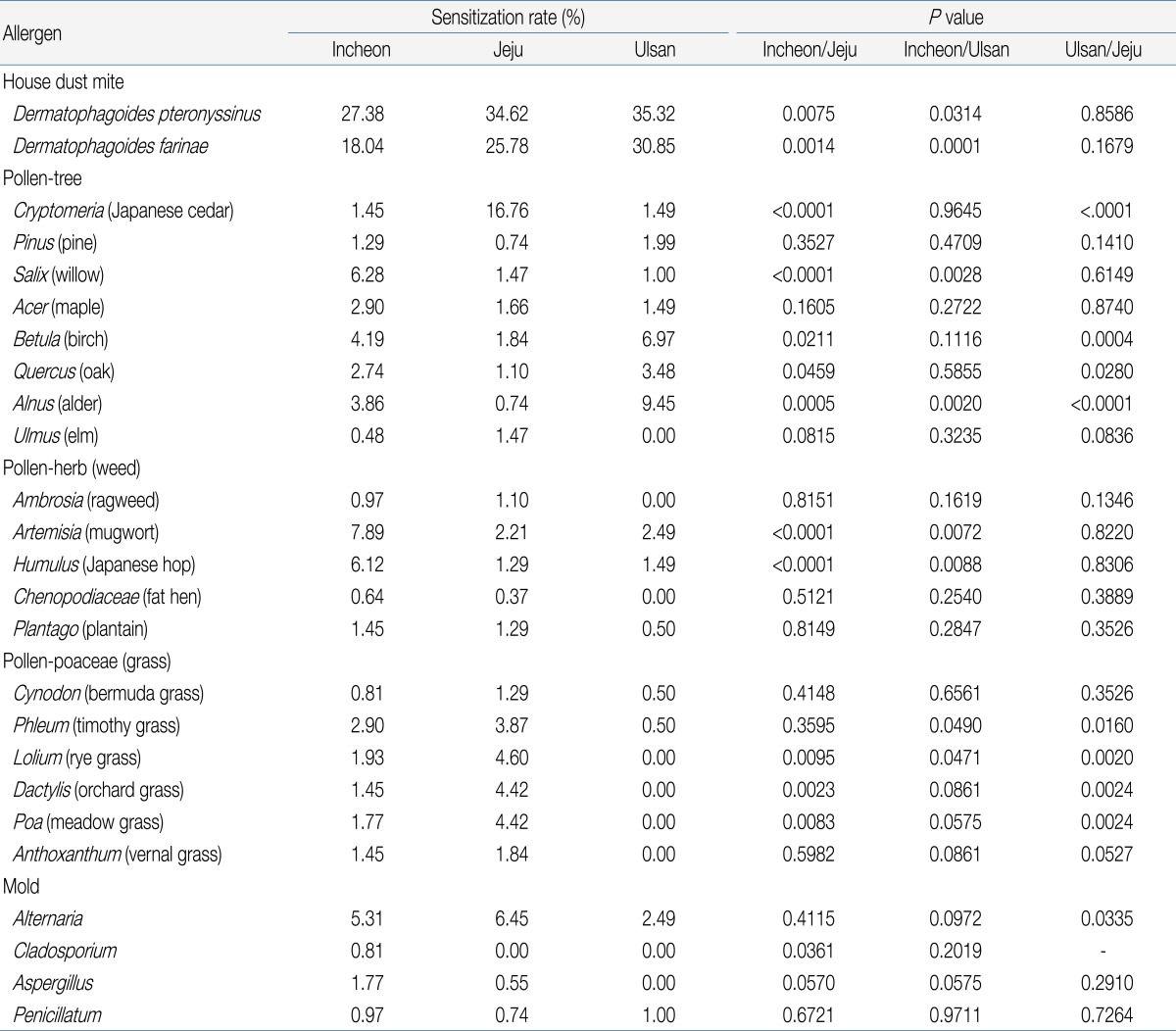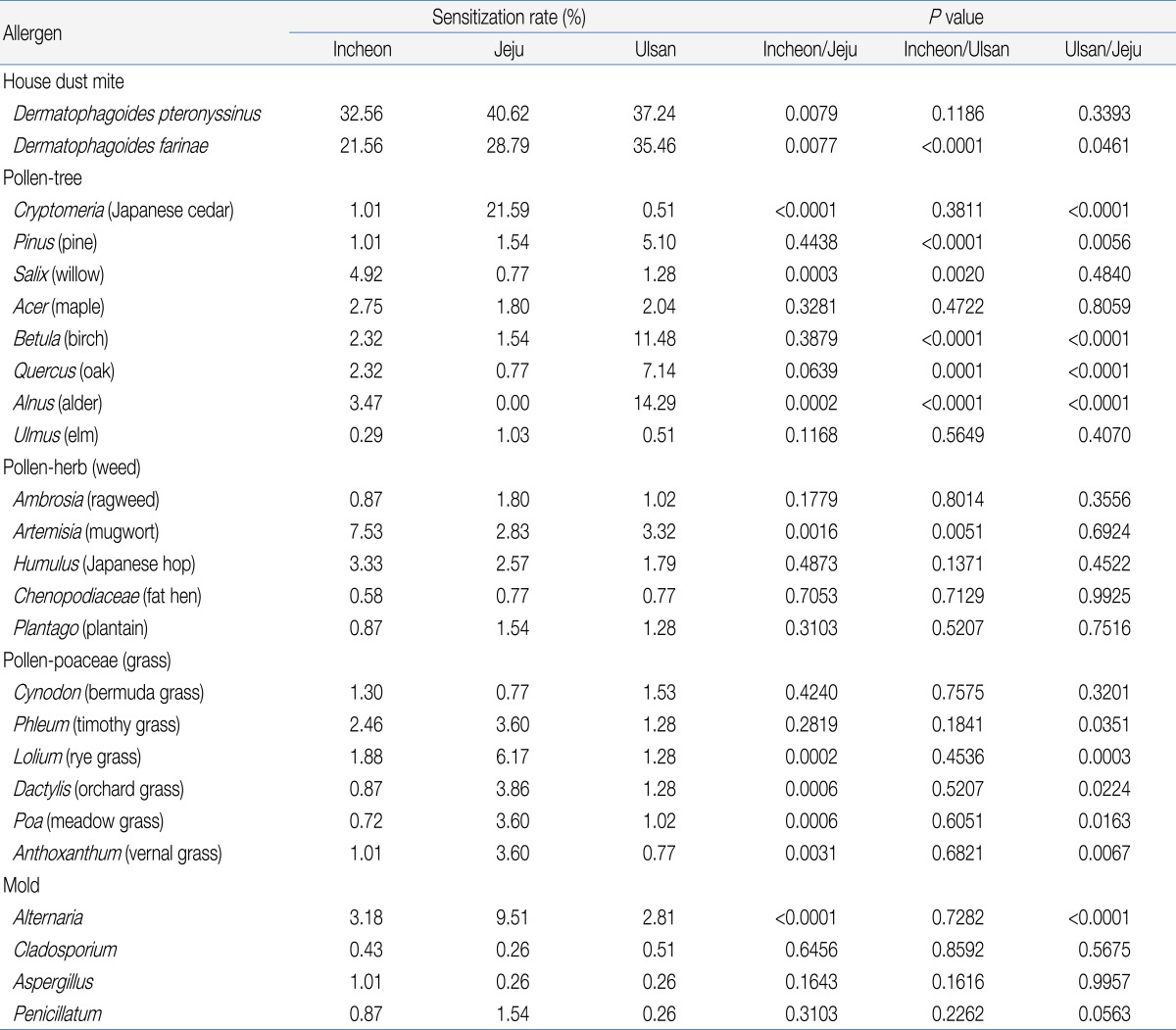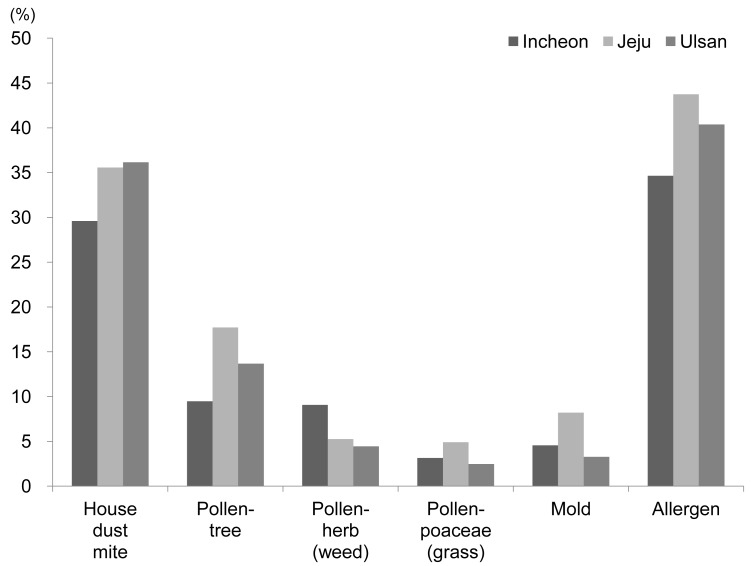Abstract
Purpose
Aeroallergens are important causative factors of allergic diseases. Previous studies on aeroallergen sensitization rates investigated patients groups that had visited pediatric allergy clinics. In contrast, we investigated sensitization rates in a general population group of elementary school to teenage students in Incheon, Jeju, and Ulsan.
Methods
After obtaining parental consent, skin-prick tests were performed on 5,094 students between March and June 2010. Elementary school students were tested for 18 common aeroallergens, whereas middle and high school students were tested for 25 allergens. The 25 allergens included Dermatophagoides pteronyssinus, Dermatophagoides farinae, pollen (birch, alder, oak, Japanese cedar, pine, willow, elm, maple, Bermuda grass, timothy grass, rye grass, orchard grass, meadow grass, vernal grass, mugwort, Japanese hop, fat hen, ragweed, and plantain), and mold (Penicillatum, Aspergillus, Cladosporium, and Alternaria).
Results
The sensitization rates in descending order were 25.79% (D. pteronyssinus), 18.66% (D. farinae), 6.20% (mugwort), and 4.07% (willow) in Incheon; 33.35% (D. pteronyssinus), 24.78% (D. farinae), 15.36% (Japanese cedar), and 7.33% (Alternaria) in Jeju; and 32.79% (D. pteronyssinus), 30.27% (D. farinae), 10.13% (alder), and 8.68% (birch) in Ulsan. The dust mite allergen showed the highest sensitization rate among the 3 regions. The sensitization rate of tree pollen was the highest in Ulsan, whereas that of Alternaria was the highest in Jeju. The ragweed sensitization rates were 0.99% in Incheon, 1.07% in Jeju, and 0.81% in Ulsan.
Conclusion
The differences in sensitization rates were because of different regional environmental conditions and distinct surrounding biological species. Hence, subsequent nationwide studies are required.
Keywords: Allergens, Sensitization, Child
Introduction
The prevalence of allergic diseases such as asthma, allergic rhinitis, and atopic dermatitis have increased rapidly worldwide during the past 30 years1,2). In Korea, this increase is because of improvements in environmental hygiene, environmental pollution augmentation, and the westernized form of residential environments3-5). To systemically manage the increasing prevalence of allergic diseases, data regarding precipitating factors is required.
In Korea, skin tests revealed that the highest positive rate was for house dust mite antigen in patients with respiratory and allergic diseases, with rates ranging from 69 to 93%6-10). As such, house dust mite antigens play a major role in allergic diseases, yet studies on pollen antigens have been insufficient11,12). However, since pollens such as ragweed allergen and mold are recently emerging as the cause of allergic diseases in children, the number of patients suffering from seasonal allergic rhinitis and allergic conjunctivitis is increasing13-16). Increased pollen has been shown in domestic environments, and studies have revealed a significant association between pollen concentration and the occurrence of allergic diseases in children17). Air pollen is closely related to weather, especially temperature, and recent reports have indicated that changes of pollen and allergenicity are related to global warming18).
Therefore, further data on air pollen and mold is required. Previous domestic reports on the sensitization rates to pollen and mold have mostly investigated patients who had visited allergy centers, and studies based on the general population are rare. In this study, we investigated the sensitization rates of aeroallergens in a general population group of children and adolescents living in the cities of Incheon, Jeju, and Ulsan.
Materials and methods
1. Subjects
The subjects of this study were 5,094 school age children and adolescents living in Incheon, Jeju, and Ulsan. Schools were randomly selected and included 19 schools in Incheon Metropolitan City (8 elementary schools, 5 middle schools, and 6 high schools), 13 schools in Jeju Special Self-Governing Province (6 elementary schools, 3 middle schools, and 4 high schools), and 8 schools in Ulsan Metropolitan City (4 elementary schools, 2 middle schools, and 2 high schools). Skin prick tests (SPTs) were performed using aeroallergens after obtaining parental consent between March and June in 2010.
2. Allergens used in SPTs
Elementary school students were tested for 21 common aeroallergens, whereas middle and high school students were tested for 28 allergens (Table 1). The 25 allergens included the positive control (1% histamine), negative control (normal saline), Dermatophagoides pteronyssinus, Dermatophagoides farinae, pollen (Cryptomeria [Japanese cedar], Pinus [pine], Salix [willow], Acer [maple], Betula [birch], Quercus [oak], Alnus [alder], Ulmus [elm], Ambrosia [ragweed], Artemisia [mugwort], Humulus [Japanese hop], Chenopodiaceae [fat hen], Plantago [plantain], Cynodon [Bermuda grass], Phleum [timothy grass], Lolium [rye grass], Dactylis [orchard grass], Poa [meadow grass], Anthoxanthum [vernal grass]), and mold (Penicillatum, Aspergillus, Cladosporium, and Alternaria). The 18 allergens used on elementary school students were the same as the above with the exception of Ulmus, Chenopodiaceae, Plantago, Lolium, Dactylis, Poa, and Anthoxanthum.
Table 1.
Skin Prick Test Allergen
The positive and negative controls and all allergens except Chenopodiaceae were manufactured by Allerpha International (Seoul, Korea). The reagents for Chenopodiaceae were manufactured by Shin Kwang New Drugs Company (Seoul, Korea).
In this report, the pollen name is indicated by the scientific name according to the internationally accepted notation of the International Code of Botanical Nomenclature, and the English name is written in parentheses to facilitate comprehension of the scientific name. Generic names that were difficult to classify morphologically are written as family names.
3. SPTs
SPT was performed as follows. We sterilized forearms of students with an alcohol swab and introduced the reagent at constant 2.5 cm intervals. The cutting edge of the lancet was held flush with the skin, and pricks were administered with consistent intensity and depth. After 15 minutes, results were read according to wheal and flare size. A wheal more than 3 mm in diameter and larger, produced by positive control (1% histamine) was considered a positive result. For middle and high school students, SPTs were carried out with 14 types of allergens on each arm. For elementary school students, 10 allergens were pricked on 1 arm and the remaining allergens on the other arm. To exclude errors related to the time of day of the examination, all examinations were performed in the morning by trained inspectors.
4. Statistical analysis
All statistical analyses were performed using SAS ver. 9.1.3 (SAS Institute Inc., Cary, NC, USA). The chi-sqare test was used for comparison of discontinuous variables. A P value of <0.05 (Bofferoni corrected P=0.0167) was considered statistically significant.
Results
1. Demographic characteristics
A total of 5,094 students (2,478 females and 2,616 males) were tested for SPT reactivity. The population included 2,320 students in Incheon (1,116 females and 1,204 males), 1,549 students in Jeju (785 females and 764 males), and 1,225 students in Ulsan (577 females and 648 males) by region and 2,290 elementary school students (3rd to 5th grade, 9 to 11 years old), 1,344 middle school students (1st to 2nd grade, 13 to 14 years old), and 1,460 high school students (1st grade, 16 years old) by age (Table 2).
Table 2.
Participating Students by Region (Incheon, Jeju, and Ulsan)
2. Comparison of sensitization rate between the 3 regions SPT results in elementary school students
The sensitization rate of Cryptomeria was highest in Jeju (11.18%) compared to the other regions (P=0.0003). Differences in the sensitization rates of Cryptomeria were observed between Incheon and Jeju and between Ulsan and Jeju, but no difference was observed between Incheon and Ulsan (P=0.8016). Pinus antigen was positive in 2.53% participants in Ulsan, which was significantly higher than that in the other regions. The sensitization rates of Betula, Quercus, and Alnus allergens were significantly higher in Ulsan, whereas the sensitization rate of Ambrosia allergen was not markedly different between the 3 areas. Sensitization rate of Alternaria allergen was significantly higher in Jeju compared to the other areas. D. pteronyssinus positivity was 20.82% in Incheon, which was lower than that in other regions, while D. farinae positivity was 26.79% in Ulsan, which was significantly higher than that in other areas (Table 3).
Table 3.
Sensitization Rates in Elementary School Students
3. SPT results in middle school students
The sensitization rate of Cryptomeria was significantly higher in Jeju (16.76%) than in Incheon (P<0.0001) and Ulsan (P<0.0001), and was higher in middle school students than in elementary students (11.18%) in Jeju. Sensitization rate of Salix allergen was not statistically different between areas in elementary school students but was 6.28% in middle school students in Incheon, which was significantly higher than that in middle school students from other regions. Betula and Quercus allergens were lower in Jeju than in the other regions. Phleum showed a low positivity in Ulsan (0.50%). The sensitization rate of Lolium was different among the 3 regions: 1.93% in Incheon, 4.60% in Jeju, and 0.00% in Ulsan. The sensitization rate of Alternaria was significantly different only between Jeju and Ulsan (P=0.0335). The sensitization rates of both allergens of D. pteronyssinus and D. farinae were lower in Incheon compared to the other 2 regions (Table 4).
Table 4.
Sensitization Rates in Middle School Students
4. SPT results in high school students
The sensitization rate of Cryptomeria was significantly higher in Jeju (21.59%) than in Incheon and Ulsan. The sensitization rate of Pinus was significantly different in Ulsan (5.10%) compared with the other 2 areas. The sensitization rates of Betula and Quercus were 11.48% and 7.14%, respectively, in Ulsan, which were higher than those in the other 2 regions. The positivity of Lolium, Dactylis, Poa, and Anthoxanthum was highest in Jeju. The sensitization of Alternaria allergen was highest in Jeju and similar in both elementary and middle school students. A statistical difference was observed in D. pteronyssinus allergen sensitization between Incheon and Jeju, and D. farinae allergen in all 3 regions. The sensitization rate of Dermatophagoides spp., which was the highest among all allergens, was similar among elementary and middle school students and was highest in high school students (Table 5).
Table 5.
Sensitization Rates in High School Students
5. Comparison of sensitization rates according to region
The overall sensitization rates of allergen according to 3 areas were shown on Figs. 1, 2. The sensitization rate of Cryptomeria was significantly higher in Jeju (15.36%) than in the other 2 regions, whereas the Pinus allergen sensitization rate was significantly higher in Ulsan. Sensitization rates of Betula and Quercus allergen were both highest in Ulsan. The sensitization rates of Artemisia and Humulus allergens were highest in Incheon. The sensitization rates of Phleum, Lolium, Dactylis, Poa, Anthoxanthum, and Alternaria were highest in Jeju. The sensitization rate of D. pteronyssinus allergen, which was the highest in all 3 regions, was highest in Jeju and lowest in Incheon, similar to that of the D. farinae allergen. Excluding D. spp., the 2 highest allergen sensitization rates by region were for Artemisia (6.20%) and Salix (4.07%) in Incheon, Cryptomeria (15.36%) and Alternaria (7.33%) in Jeju, and Alnus (10.13%) and Betula (8.68%) in Ulsan.
Fig. 1.
Sensitization rates of allergen according to region.
Fig. 2.
Sensitization rates of pollen according to region. Cryptomeria, Japanese cedar; Pinus, pine; Salix, willow; Acer, maple; Betula, birch; Quercus, oak; Alnus, alder; Ulmus, elm; Ambrosia, ragweed; Artemisia, mugwort; Humulus, Japanese hop; Chenopodiaceae, fat hen; Plantago, plantain; Cynodon, bermuda grass; Phleum, timothy grass; Lolium, rye grass; Dactylis, orchard grass; Poa, meadow grass; Anthoxanthum, vernal grass.
Discussion
Pollen and mold are important allergens, and higher proportions of allergic diseases are now related to pollen and mold11). Sensitization rate studies of pollen and mold are insufficient because of the lower allergenicities of pollen and mold compared to the house dust mite. Therefore, we investigated the sensitization rates of pollen and mold in a general population group of school age children. The aeroallergens that showed high sensitization rates differed between regions and sensitization to these aeroallergens tended to increase with age.
Cryptomeria, which was first imported in Jeju for use in forest windbreaks and is mostly cultivated in the Seogwipo region, is an important allergen in Jeju. Excluding D. spp., the sensitization rate of Cryptomeria was highest in Jeju. According to data published in 2010, the sensitization rate of Cryptomeria was 9.7% in 1998 and 18.2% in 2008 in students in Jeju. Thus, this sensitization has increased within 10 years and has also increased with age17). The positivity of Cryptomeria in Jeju in our study is similar to that reported in previous studies. In addition, the tendency of the sensitization rates of Cryptomeria to increase with increasing age is similar to previous reports. However, a limitation of our study is that we did not show temporal changes in our subjects because this requires a repetitive SPT in the same subjects.
Betula, Quercus, and Alnus positivity was highest in Ulsan. These pollens belong to the Betulaceae family and are high in allergenicity. These temperate plants are mostly distributed in Korea, especially in the southern area14). The highest positivity in Ulsan reflects the high exposure rate of this allergen in the area, which is located in southern Korea. Tree pollen was a main allergen with significant importance in patients living in areas of high exposure who showed strong positivity to pollen in the SPT.
In our study, for elementary school students going on to middle school in Incheon and Jeju the sensitivity increased along with the age, but in Ulsan the subjects showed a pattern of decreasing sensitivity on tree pollens excluding Alnus. In all three regions, the antigens were tested with device from the same medical corporation, and there were no denaturalization in antigens to note of. Our research is a cross-sectional study, and while it is possible to perceive a generalized trend according to age group, there is a limitation in comparing sensitivity among age groups, which is why we are in need of a longitudinal study in the future.
In Jeju, the sensitization rate of grass pollen other than Cynodon was high. The sensitization rate of 4.91% in our study was not significantly different from the sensitization rate of 3.3% reported in previous studies17). Grass pollen is scattered from the end of April to November, with strong allergenicity during this period. Because grass is cultivated in areas that people inhabit, the prevalence rate of pollenosis to grass pollen is high19). In particular, the positivity of grass pollen is high in Jeju because of the warm and humid climate.
The pollen of Pinus is scattered from spring to summer, and although the amount of pollen is high in Korea, the allergenicity is reported to be low19). However, the positivity reached levels of up to 3.08% in the students in our study.
Ambrosia, a representative weed that causes pollenosis in autumn, emerged as an important pollen allergen when trade with foreign countries became active in the 1970s19). The distribution of ragweed is now increasing rapidly all over the country. The positivity of ragweed was 7.1% in a study conducted in 2003 that analyzed patients who had visited allergy clinics in Seoul, Gwangju, Busan, and Daegu15). This study showed that the positivity of ragweed has been increasing every year in pediatric patients due to the hazardous environment created by increases in ragweed propagation, traffic growth, apartment buildings, and air pollution. However, the sensitization rate of ragweed was approximately 1% in the general population in the 3 regions, and there was no significant difference between regions in our study. This difference between studies suggests that allergens like ragweed show high positivity in patients with allergic disease and low positivity in the general population.
Although inhaled mold can cause respiratory symptoms in patients who are sensitized to it, diagnosis of mold allergy is difficult because the relationship between this allergy and clinical symptoms is unclear, and cross reactivity may occur with other allergens20). In a previous domestic study, the positivity of Alternaria and of other molds was 10% and 2 to 4%, respectively, in children with atopy20). In our study, the sensitization rate of Alternaria was highest among the 4 species of mold tested. This rate was especially high in Jeju because Alternaria grows mainly in regions of high humidity (-2 to 25%).
D. spp., the most important allergen in pediatric allergic diseases, differs in type and density according to region. According to domestic literature, the most common kind of house dust mite in Korea is D. farinae21). Previous studies indicated that the D. spp. sensitization rates reach up to 70% in pediatric patients with allergic diseases, while sensitization rates were around 20 to 30% in the general pediatric population21,22). Although D. farinae is known to be dominant, our study revealed a lower positivity of D. farinae compared to D. pteronyssinus by SPTs conducted under the same conditions. To clarify this difference, allergy skin test data from other regions is required.
Our study was conducted between March and June. There was a previous study investigating the sensitization rates of aeroallergens in elementary and middle school students during October and November23). The sensitization rate of tree pollen in Ulsan of our study was higher than that of the previous study, and grass pollen showed similar sensitization rates of less than 1 percent difference. Ragweed, a weed pollen which is prevalent in the atmosphere from July to December, also showed similar sensitization rates of less than 1 percent difference. There are limitations of this study that it was conducted during a specific season. However, comparison of sensitization rates with a study conducted during a different season revealed that there were no seasonal differences in sensitization rates of pollen allergens except tree pollen.
Because allergen exposure rates differ depending on regional climate and environment, sensitization rates were characterized according to these differences in our study. Further studies in other cities are required for obtaining nationwide data. In addition, the correlation between allergic diseases and pollen or mold as a causative allergen may be determined by further research on the prevalence rate of allergic diseases in other areas. We anticipate that subsequent studies and nationwide research based on these data will enable the development of preventive measures to promote national health.
In conclusion, the sensitization rates of pollen were 15 to 20%, and the sensitization rates of mold were 3 to 8%. The sensitization rates including D. pteronyssinus and D. farinae were 34 to 44%.
Difference in exposure rates to allergens with increasing age result in difference in sensitization rates. These differences in sensitization rates are due to different regional living environmental conditions and distinct surrounding biologic species. It may be useful to manage allergic diseases by continuous investigation related to this study on a national scale and systematical observation of the regional differences and chronological changes of living environments.
Acknowledgment
This work was supported by the Ministry of Environment and Inha University.
References
- 1.Hong CE. Textbook of pediatrics. 9th ed. Seoul: Korea Textbook Publishing Co.; 2008. pp. 1105–1106. [Google Scholar]
- 2.Beasley R, Crane J, Lai CK, Pearce N. Prevalence and etiology of asthma. J Allergy Clin Immunol. 2000;105(2 Pt 2):S466–S472. doi: 10.1016/s0091-6749(00)90044-7. [DOI] [PubMed] [Google Scholar]
- 3.Hong SJ, Ahn KM, Lee SY, Kim KE. The prevalences of asthma and allergic diseases in Korean children. Korean J Pediatr. 2008;51:343–350. [Google Scholar]
- 4.Hong SJ. Korean ISAAC Study Group of Korean Association of Allergy and Respiratory Disease: Report of Korean ISAAC epidemiologic study for asthma and allergic diseases in children. Pediatr Allergy Respir Dis. 2007;17(Suppl 1):55–66. [Google Scholar]
- 5.Lee SI, Shin MH, Lee HB, Lee JS, Son BK, Koh YY, et al. Prevalences of symptoms of asthma and other allergic diseases in Korean children: a nationwide questionnaire survey. J Korean Med Sci. 2001;16:155–164. doi: 10.3346/jkms.2001.16.2.155. [DOI] [PMC free article] [PubMed] [Google Scholar]
- 6.Seo HS, Park YO, Chen MF, Lee YC. Results of skin test, IgE in pediatric patients with respiratory allergies in Incheon and Kyung Ki area. Allergy. 1988;8:271–278. [Google Scholar]
- 7.Kim WY, Yeo MH, Lim BH, Kang IJ. Relationship between skin test and eosinophil count total IgE & RAST in children with allergic symptoms. J Korean Pediatr Soc. 1990;33:1244–1254. [Google Scholar]
- 8.Ahn YM, Choi EY. The result of skin prick tests with 9 common aeroallergen in Korea and RAST reactivity to D. farinae in a community school children. Allergy. 1990;10:213–225. [Google Scholar]
- 9.Kim HJ, Choi YJ, Jeon GR, Lee KS, Lee SY. A study on the animal epithelium as a causative allergen in children with asthma and rhinitis. Pediatr Allergy Respir Dis. 2002;12:192–200. [Google Scholar]
- 10.Lee KY, Kim KE. A study on the method of exclusion of unnecessary allergens from the vaccines for immunotherapy. Allergy. 1988;8:150–164. [Google Scholar]
- 11.Lee SY, Park JS, Lee KS, Hong CH. Pollen allergy in children (ll): the significance of tree pollen as a causative allergen in children with allergic diseases. J Korean Pediatr Soc. 1998;41:799–807. [Google Scholar]
- 12.Oh JW, Kang IJ, Kim SW, Kook MH, Kim BS, Cheong JT, et al. The association between the concentration of pollen and outbreak of pollinosis in childhood. Pediatr Allergy Respir Dis. 2009;19:4–11. [Google Scholar]
- 13.Oh JW, Lee HB, Lee HR, Pyun BY, Ahn YM, Kim KE, et al. Aerobiological study of pollen and mold in Seoul, Korea. Allergol Int. 1998;47:263–270. [Google Scholar]
- 14.Oh JW, Lee HR, Kim JS, Lee KI, Kang YJ, Kim SW, et al. Aerobiological study of pollen and mold in the 10 states of Korea. Pediatr Allergy Respir Dis. 2000;10:22–33. [Google Scholar]
- 15.Oh JW, Kang IJ, Kim SW, Kook MH, Kim BS, Shin KS, et al. The correlation between increased sensitization rate to weeds in children and the annual increase in weed pollen in Korea. Pediatr Allergy Respir Dis. 2006;16:114–121. [Google Scholar]
- 16.Solomon WR, Burge HA, Muilenberg ML. Allergen carriage by atmospheric aerosol. I. Ragweed pollen determinants in smaller micronic fractions. J Allergy Clin Immunol. 1983;72(5 Pt 1):443–447. doi: 10.1016/0091-6749(83)90579-1. [DOI] [PubMed] [Google Scholar]
- 17.Jeon BH, Lee J, Kim JH, Kim JW, Lee HS, Lee KH. Atopy and sensitization rates to aeroallergens in children and teenagers in Jeju, Korea. Korean J Asthma Allergy Clin Immunol. 2010;30:14–20. [Google Scholar]
- 18.Beggs PJ. Impacts of climate change on aeroallergens: past and future. Clin Exp Allergy. 2004;34:1507–1513. doi: 10.1111/j.1365-2222.2004.02061.x. [DOI] [PubMed] [Google Scholar]
- 19.Oh JW. Characteristics and distribution of airborne pollen and mold. Pediatr Allergy Respir Dis. 1998;8:1–15. [Google Scholar]
- 20.Shin JH. Fungus and allergy. Pediatr Allergy Respir Dis. 1999;9:13–23. [Google Scholar]
- 21.Yong TS, Jeong KY. Review on ecology of house dust mites in korea and suggestion of a standard survey method. Pediatr Allergy Respir Dis. 2011;21:4–16. [Google Scholar]
- 22.Ree HI, Jeon SH, Lee IY, Hong CS, Lee DK. Fauna and geographical distribution of house dust mites in Korea. Korean J Parasitol. 1997;35:9–17. doi: 10.3347/kjp.1997.35.1.9. [DOI] [PubMed] [Google Scholar]
- 23.Kim J, Hahm MI, Lee SY, Kim WK, Chae Y, Park YM, et al. Sensitization to aeroallergens in Korean children: a population-based study in 2010. J Korean Med Sci. 2011;26:1165–1172. doi: 10.3346/jkms.2011.26.9.1165. [DOI] [PMC free article] [PubMed] [Google Scholar]



